The Comprehensive Guide to Building a Culture of Engagement

A Global Employee Recognition and Wellness Platform
In today's global business landscape, while most companies are grappling with challenges like high turnover, low productivity, lack of initiative, and a disengaged workforce, some organizations are turning the tables and redefining success by retaining their top talents with the power of recognition.
However, the outreach of employee engagement is still on fragile grounds. That is why it is important to understand that an engaged and committed workforce is one of the core keys to success.
Today Globally, especially in the US and North America, organizations are facing persistent challenges in fostering employee engagement. Factors such as increasing competition, evolving workplace dynamics, and shifting employee expectations contribute to this ongoing struggle.
Research by Gallup hints at a decline in US employee engagement, hitting a peak at 36% in 2020 (highest ever-recorded). Subsequent years saw a decrease to 34% in 2021, 33% in 2022, and a continued trend in 2023, registering only 31% engaged employees.
This shows a worrying trend of decreasing employee engagement over recent years. So, for companies to thrive, they need to tackle these challenges directly and create a workplace culture where employees are fully engaged and committed.
References from a November 2023 Gallup poll, employee engagement trends show ONLY 33% of U.S. employees are engaged, and 17% are actively disengaged. The percentage of engaged employees is higher than the 26% it was when measuring began in 2000, but it is lower than 2020's high of 36%.
In fact, a recently published report has shed light on a concerning trend – a dwindling ratio of engaged to actively disengaged employees across the United States.
The current figures paint a worrisome picture, with only 1.8 engaged employees for every disengaged individual. This alarming statistic represents a substantial decline from the 2.1 ratio observed in 2023 and a substantial plummet from the record-high ratio of 2.7 achieved back in 2019.
These figures illustrate a troubling post-COVID-19 reality, where employees are increasingly disinterested and struggling to maintain a work-life balance. The challenges in keeping them engaged are mounting, highlighting a critical issue for organizations aiming to foster a motivated and productive workforce.
It is important for companies to realise that engagement doesn't happen by chance; it results from deliberate efforts to create a supportive, inclusive, and stimulating workplace.
Understanding Employee Engagement
Takeaways
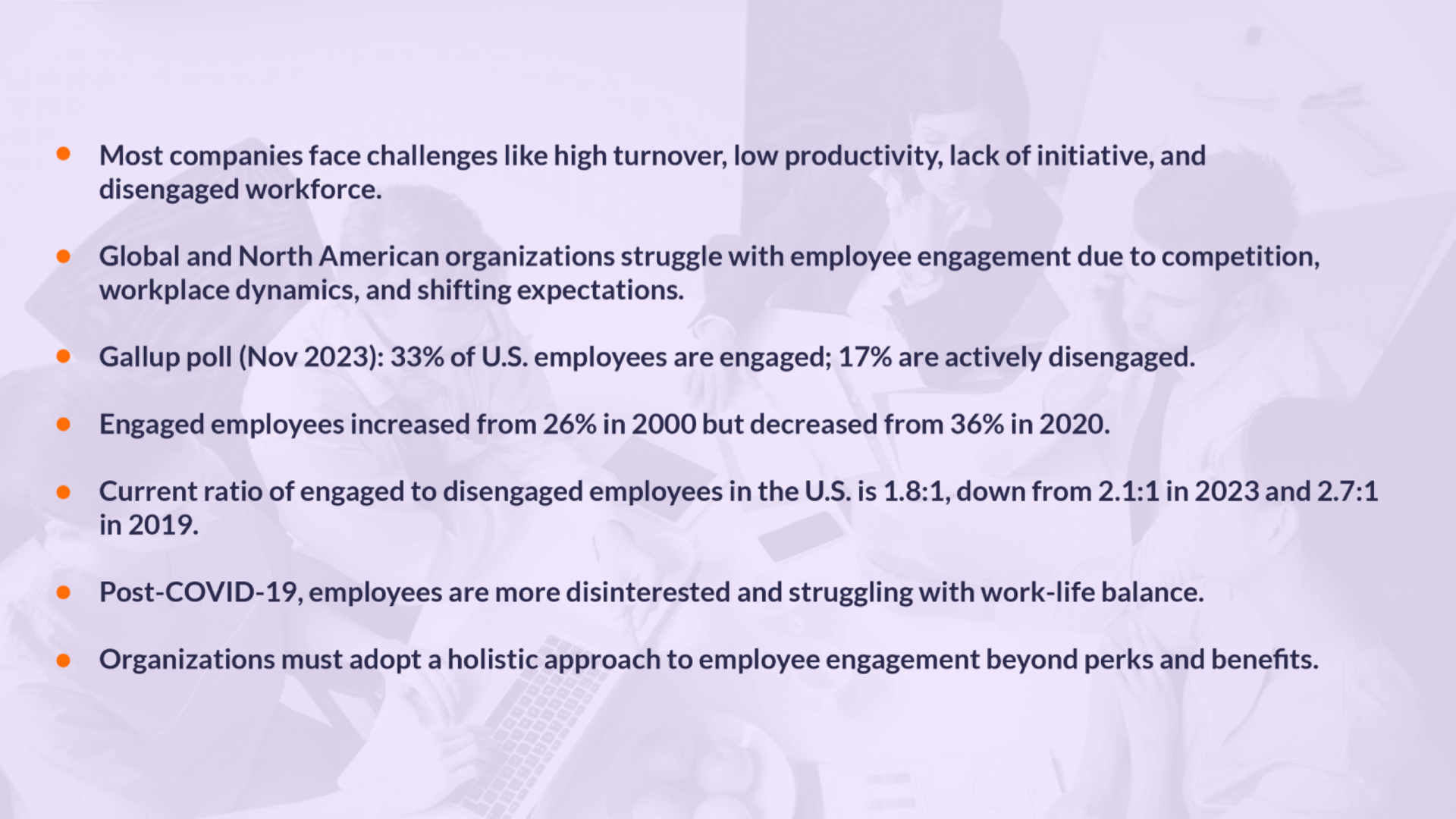
Let us first understand what employee engagement IS NOT. Although many companies go for all-in one employee benefits they often miss the mark on fostering true engagement. They succumb to the myth that talented folks flock solely to cushy perks.
Employee engagement is much more than that. It is the level of emotional commitment, dedication, and involvement an employee has in their work and organization. It goes beyond just being satisfied with the job or showing up to work each day.
It is also important to remember that true employee engagement is a collaborative effort, where both the organization and its employees are committed to building a mutually beneficial relationship.
To harness the true power of employee engagement, organizations must adopt a holistic approach that goes beyond just offering attractive perks and benefits.
Key Reasons for Decline in Employee Engagement
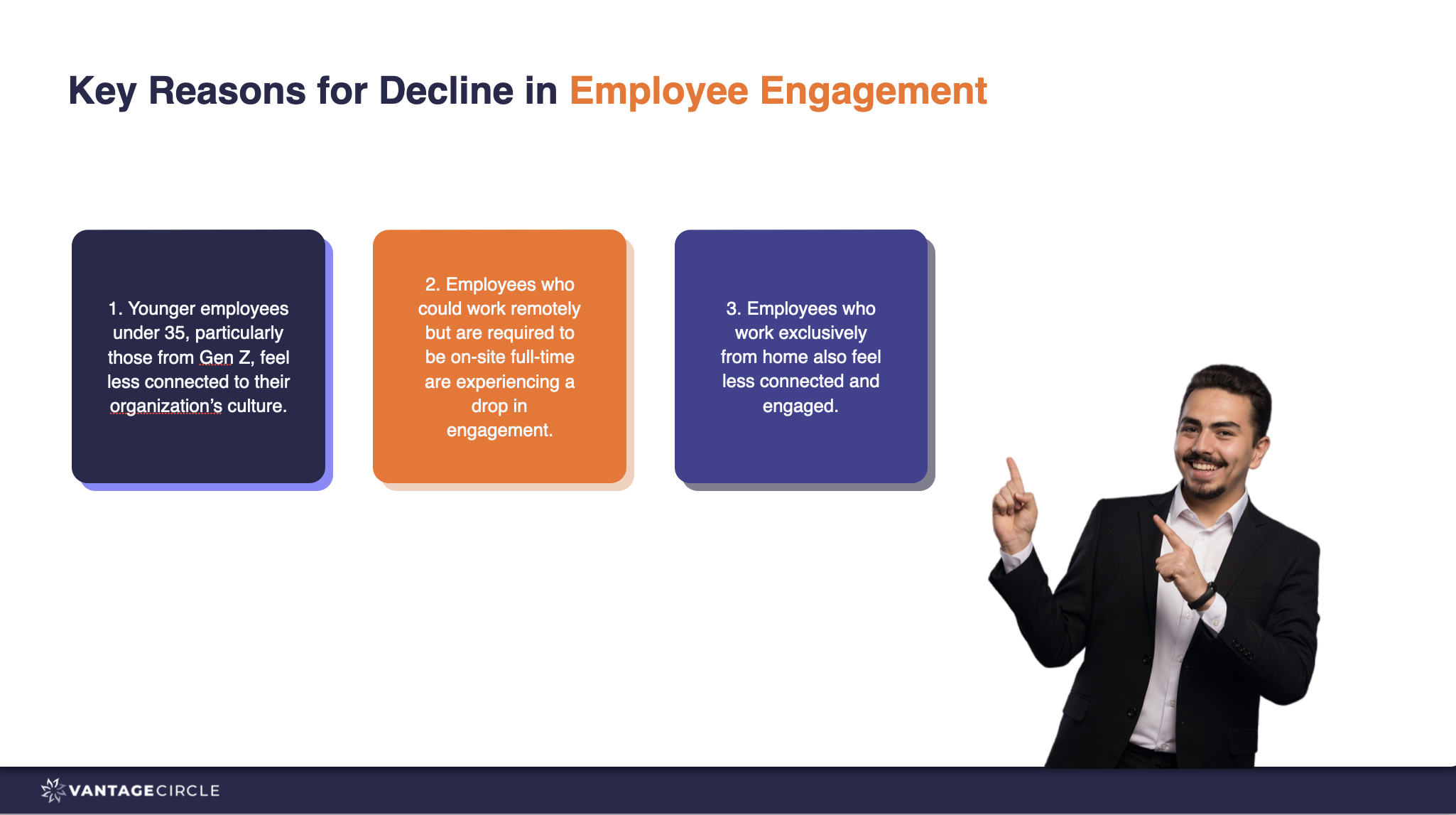
Key Benefits of Employee Engagement
1. Boosted Productivity
Engaged employees are star performers who go the extra mile. Their increased productivity drives positive business results.
2. Enhanced Retention
Employees stay longer when they feel connected to their work. Recognize their efforts and support their growth to keep them committed.
3. Increased Profitability
Engaged employees boost company profits. Studies show they can generate 26% more revenue, enhancing overall performance.
4. Reduced Absenteeism
Frequent absence hurt productivity and customer satisfaction. Engaged employees love their work and show up consistently.
5. Improved Customer Satisfaction
Happy employees create happy customers. When employees are engaged, they deliver excellent service, leading to satisfied customers and higher profits.
6. Greater Employee Satisfaction
Employees feel good when they know their work matters. Recognize their achievements to lift morale and improve the customer experience.

Source: Gallup and HR Dive
Developing an Employee Engagement Strategy
A successful employee engagement strategy involves a comprehensive plan to engage employees in the organization’s mission, values, and goals.
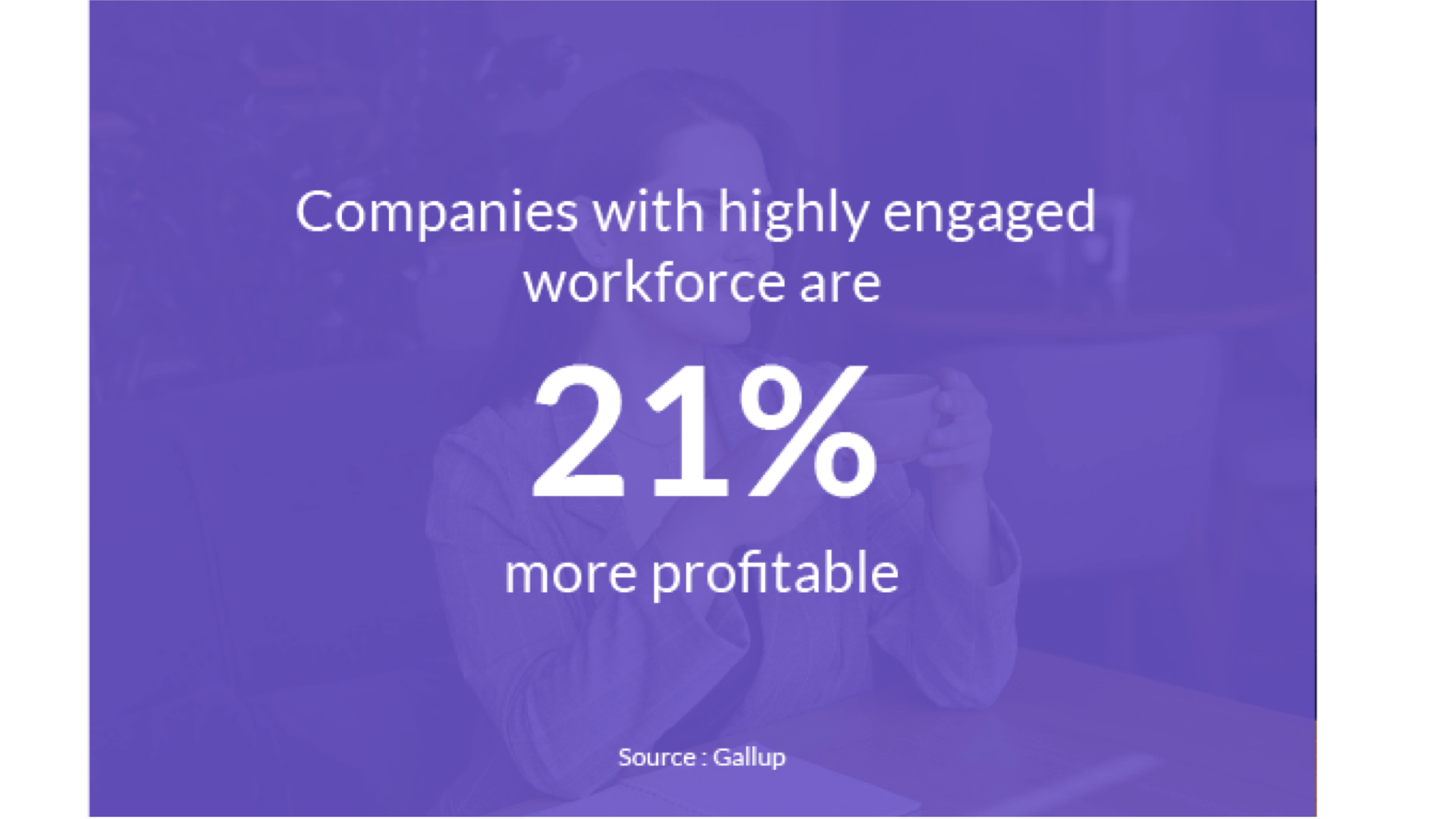
It includes fostering open communication, providing growth opportunities, recognizing achievements, and creating a positive work environment. The purpose of developing a robust engagement strategy sum down to three important factors;
-
Empower Growth: Offer opportunities for skill development and advancement to keep employees motivated and fulfilled.
-
Celebrate Success: Recognize and reward achievements to foster a culture of appreciation and engagement.
-
Cultivate Connection: Foster open communication and a positive work environment to build strong bonds and loyalty among employees.
Must Have's of an Employee Engagement Strategy
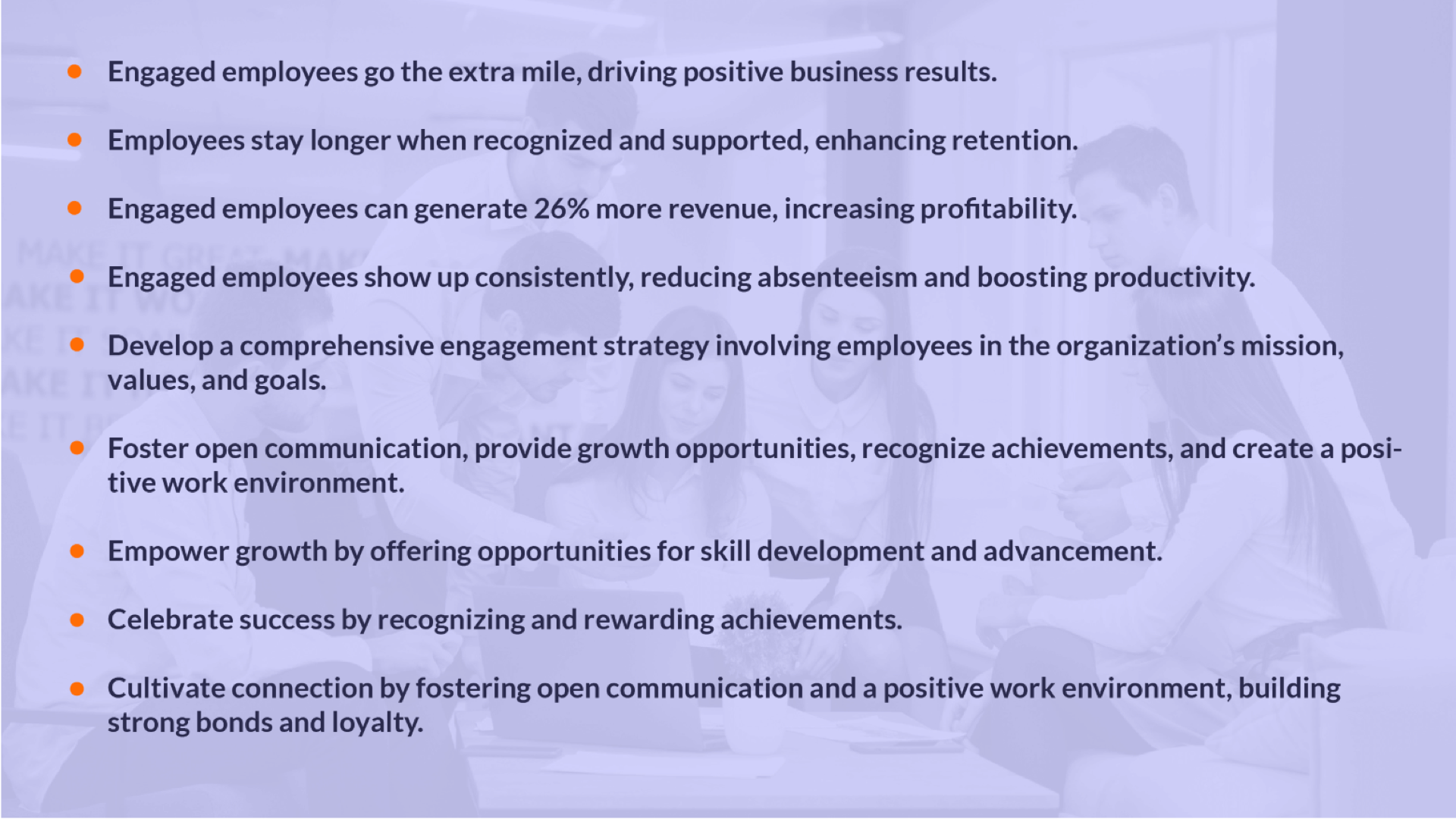
Key Strategies for Building a Culture of Engagement
Do you think developing an employee engagement strategy is optional? Think again as;
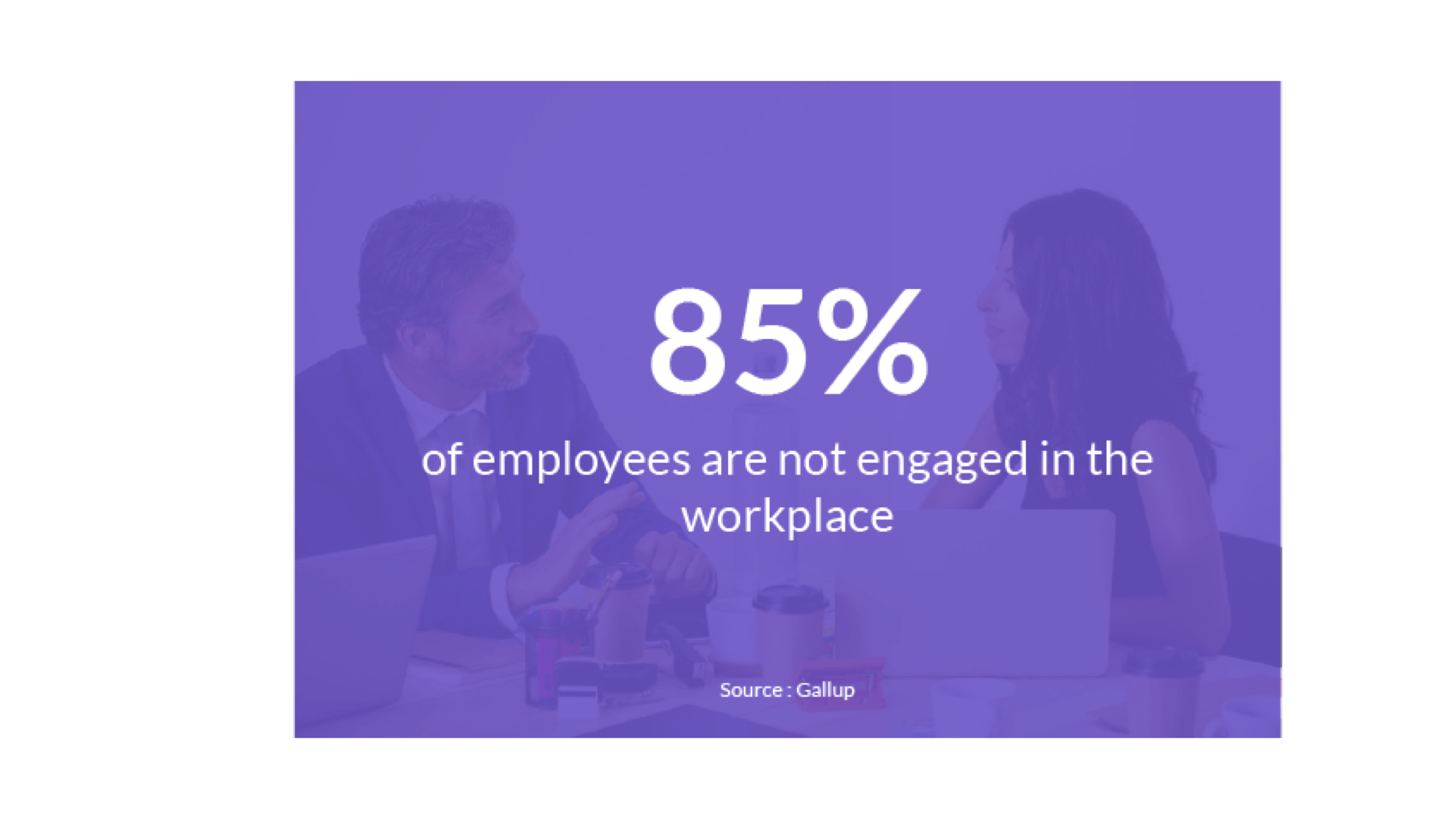
This means with 85% of employees not engaged at work, only 15% are truly connected and motivated.However, efficient engagement strategies can be a real game-changer to tip these numbers up.
Let's take a peek at some of the effective strategies organizations are putting into action.
1. Promote Open Communication
Encourage various channels for employees to share their thoughts and ideas openly. This fosters transparent workplace communication, a cornerstone for collaboration. Employees should feel empowered to communicate openly with managers, HR, or peers.
A study by Mckinsey observed that employees who feel included in more detailed workplace communication are almost 5 times more likely to report increased productivity.
How to do it?
Promote open communication through town hall meetings, suggestion boxes, anonymous feedback systems, or casual chats.
Why is this strategy crucial?
- Boosts transparency and trust.
- Sparks creativity and problem-solving.
- Minimizes misunderstandings and conflicts.
- Cultivates strong relationships and a collaborative culture.
2. Provide Growth Opportunities
Invest in your employees' future by investing in their growth. Provide them with training, education, or development programs tailored to their needs.
How to do it?
Offer a range of opportunities, such as:
- Tuition reimbursement
- Internal career mobility paths
- Mentorship programs aimed at nurturing talent within the organization, and more.
By offering these pathways, you show your commitment to their ongoing development.
Why is this approach essential?
- Retains top talent
- Elevates morale and motivation
- Enhances job satisfaction and engagement
- Builds a proficient and adaptable workforce
3. Recognize and Reward Achievements
Acknowledging and celebrating the hard work and dedication of our employees is crucial. Rewarding employees not only motivates them to sustain high performance but also contributes to fostering a positive workplace culture.
Therefore, prioritizing the implementation of a formal reward and recognition program within the organization is imperative.
Did you know?
Recognition may take various forms, including:
- Bonuses
- Promotions
- Public acknowledgment
- Unique perks tailored to individual interests
Research indicates that when employees receive acknowledgment
for their contributions, they become 18 times more likely to deliver exceptional results.
Why is this approach vital?
- Fuels employee motivation and excellence
- Reinforces positive behaviors and attitudes
- Instills a sense of accomplishment and pride
- Cultivates a culture of appreciation and recognition
4. Promote Team Building Activities
Building strong relationships and nurturing a sense of belonging among your employees is paramount. They serve to enhance collaboration within your workforce. The goal is to hone problem-solving abilities and foster camaraderie among colleagues.
By engaging in diverse team-building activities, you can cultivate shared experiences and forge deeper connections among your team members.
These activities, may include:
- Team-building events
- Workshops
- Retreats
Why is this approach critical?
- Bolsters relationships and camaraderie within teams
- Enhances communication and collaboration
- Boosts employee engagement and morale
- Elevates team performance and productivity
5. Offer Employee Assistance Programs (EAP)
Employee Assistance Programs (EAPs) are work-based intervention programs designed to assist employees in resolving personal problems that may be adversely affecting their work performance, health, and well-being.
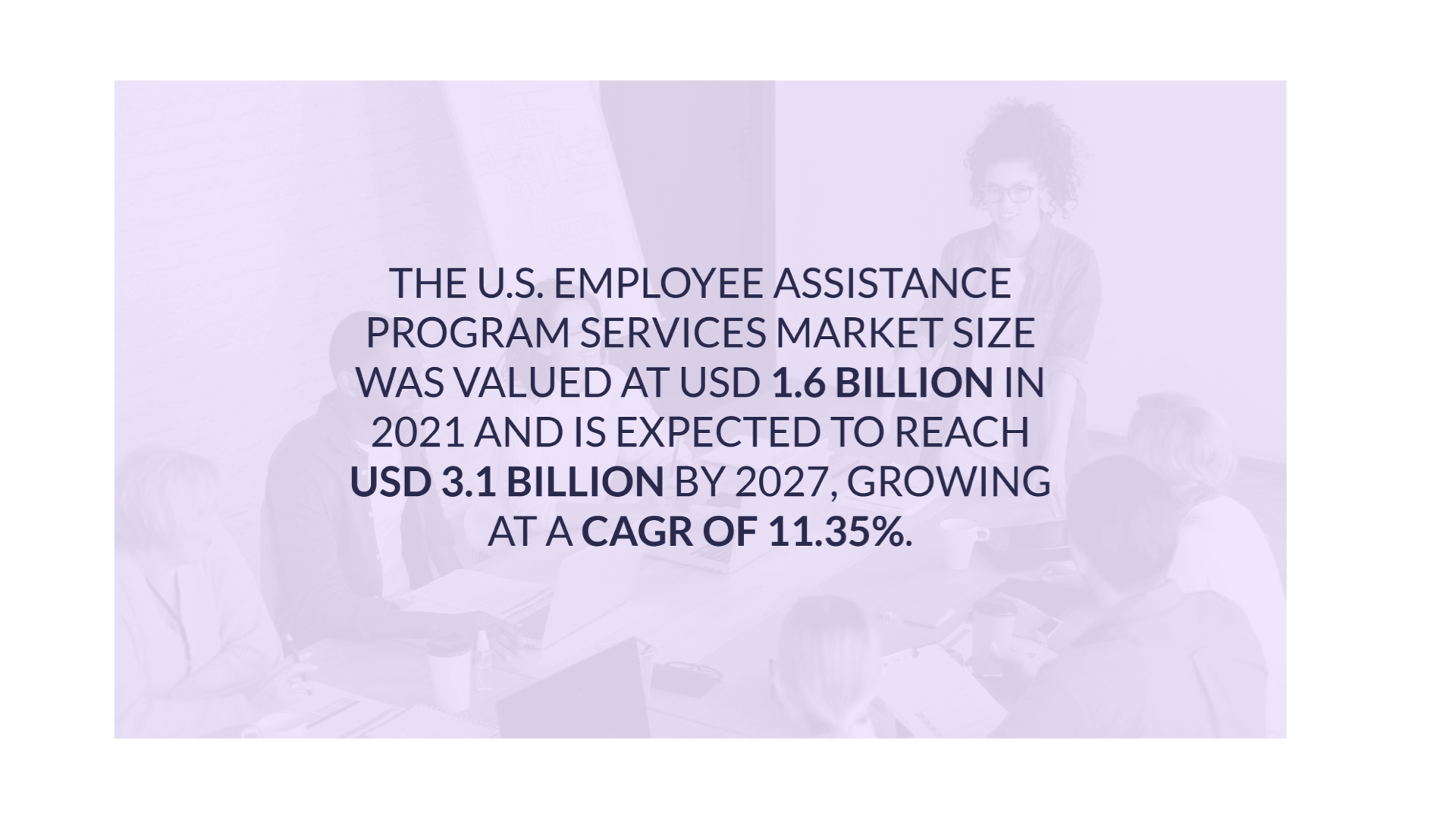
Support programs are indispensable within a company to aid employees during trying periods. These Employee Assistance Programs (EAPs) can offer invaluable support to employees grappling with stress, anxiety, depression, substance abuse issues, or relationship challenges.
How to do it?
It's imperative for management to grant access to counseling services, financial planning resources, or other assistance programs.
Why is this approach crucial?
- Attends to employee mental health and well-being
- Provides assistance to employees facing personal hardships
- Boosts employee resilience and coping mechanisms
- Elevates employee morale and job satisfaction
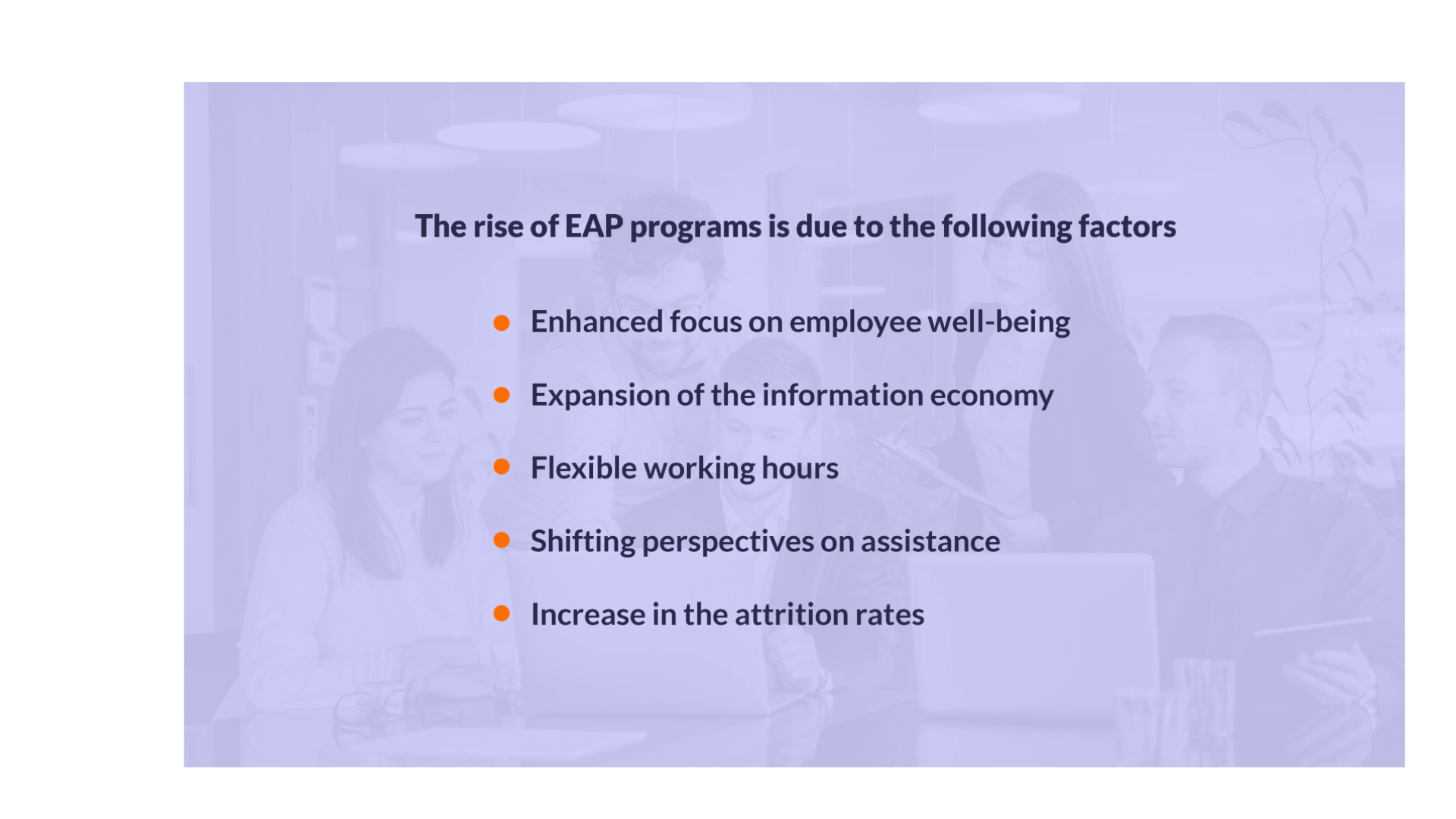
6. Provide Schedule Flexibility
Flexibility is key to accommodating the diverse needs and preferences of our employees.
How can you achieve it?
- Flexible work hours,
- Remote work options, or
- Compressed work schedule, etc.
They help accommodate the diverse needs and preferences of employees. Although it’s important to be mindful of cultural differences and consider local regulations when designing flexible work arrangements.
Why is this strategy important?
- Accommodates diverse employee needs and lifestyles
- Increases employee flexibility and convenience
- Improves work-life balance
- Enhances employee satisfaction and engagement
7. Regularly Evaluate Engagement Levels
Conduct employee surveys, focus groups, or one-on-one meetings to gather feedback on the effectiveness of engagement initiatives' and make data-driven improvements accordingly.
What's the solution?
Measure engagement levels regularly to track progress and identify areas for improvement.
Why is this strategy important?
- Monitors employee engagement and satisfaction
- Identifies areas for improvement and growth
- Enables timely intervention and corrective action
- Increases employee motivation and engagement
Based on findings from a 2021 study, a staggering 73 percent of employees are open to the idea of leaving their current jobs if they receive the right offer, regardless of whether they are actively seeking new opportunities.
Furthermore, According to SHRM, 76% of employees in the US say they are more likely to stay with a company that offers continuous learning opportunities.
Based on findings from a 2021 study, a staggering 73 percent of employees are open to the idea of leaving their current jobs if they receive the right offer, regardless of whether they are actively seeking new opportunities.
Furthermore, According to SHRM, 76% of employees in the US say they are more likely to stay with a company that offers continuous learning opportunities.
Switching jobs isn't solely driven by financial considerations. Surprisingly, 86 percent of millennials would be willing to take a pay cut for the opportunity to work in their dream job. Additionally, 23 percent of job seekers are open to changing positions without requiring a salary increase.
Steps to Create an Employee Engagement Strategy
-
Define Clear Objectives: Establish precise goals and outcomes to guide your engagement strategy effectively.
-
Assess Current Engagement Levels: Evaluate the existing levels of employee engagement to identify areas for improvement.
-
Identify Key Drivers of Engagement: Pinpoint the factors that significantly impact employee engagement within your organization.
-
Involve Stakeholders: Engage employees, managers, and leaders in the process to ensure diverse perspectives and buy-in.
-
Take Actionable Initiatives: Implement tangible and targeted initiatives based on insights gained to enhance engagement effectively.
Things to Remember in an Engagement Strategy
Before we begin, let us have a sneak peek into some must have's
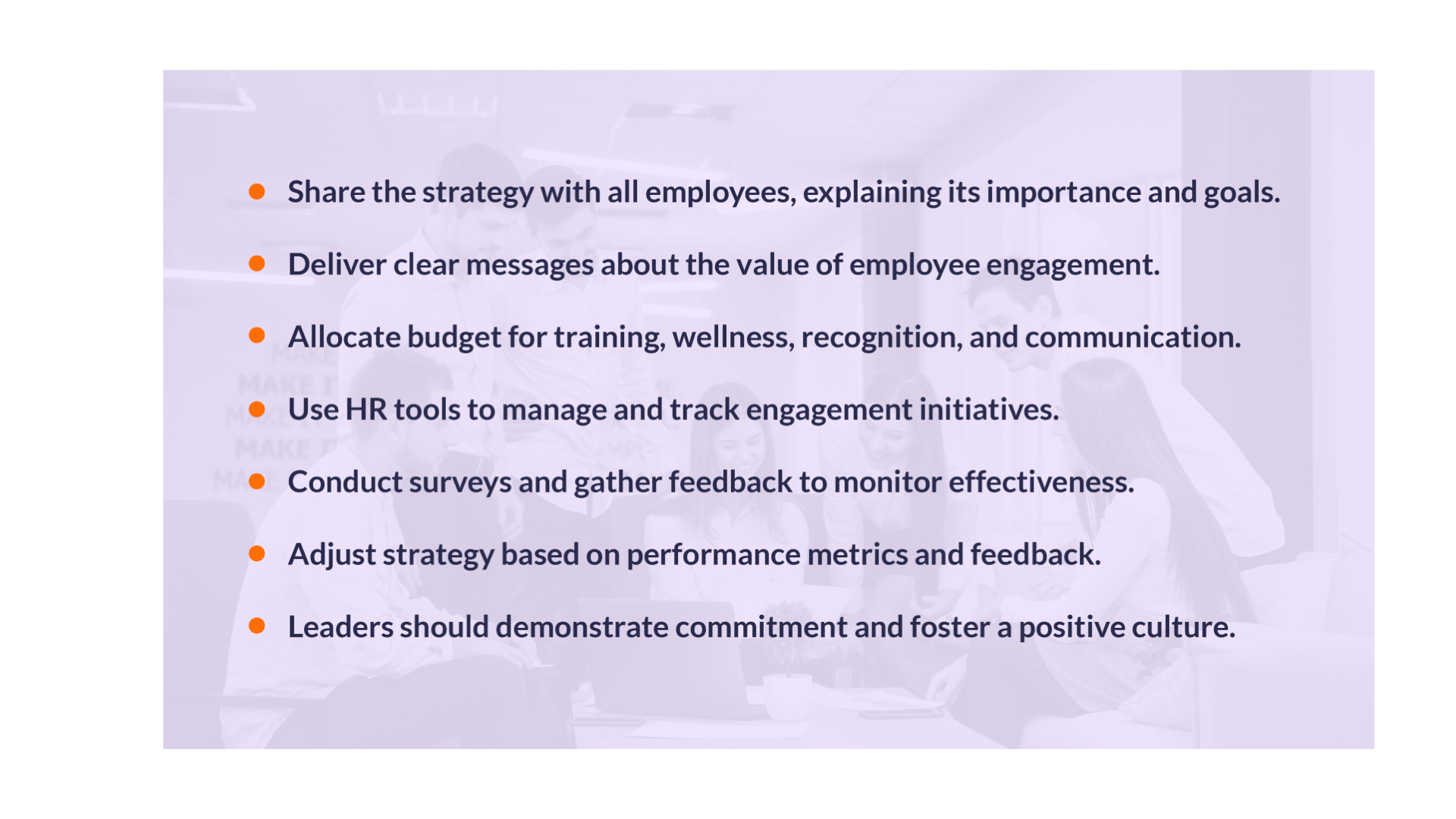
1. Communicate the Strategy
Start by sharing the engagement strategy and its objectives with all employees. Be open about why this strategy is important and how it aligns with our organization's goals.
Deliver clear and consistent messages that underscore the importance of employee engagement and its positive impact on both the individual and the organization.
2. Allocate Resources
Make sure the necessary budget is in place to support the various initiatives in your strategy. This includes funding for training programs, wellness initiatives, recognition programs, and communication efforts.
Additionally, identify and deploy the right HR tools and technologies to manage and track engagement initiatives effectively. Use HR software for employee surveys, data analysis, performance tracking, and reporting.
Many tools in the market offer solutions for these tasks. Using e-NPS-based surveys to actively listen to employee feedback and gauge engagement levels can lead to better insights and more effective engagement strategies.
3. Monitor and Adjust
Regularly monitor the effectiveness of your engagement initiatives through surveys, feedback, and performance metrics. Analyze the data to identify areas for improvement and make necessary adjustments to your strategy. Continuous evaluation ensures that your engagement efforts remain relevant and effective.
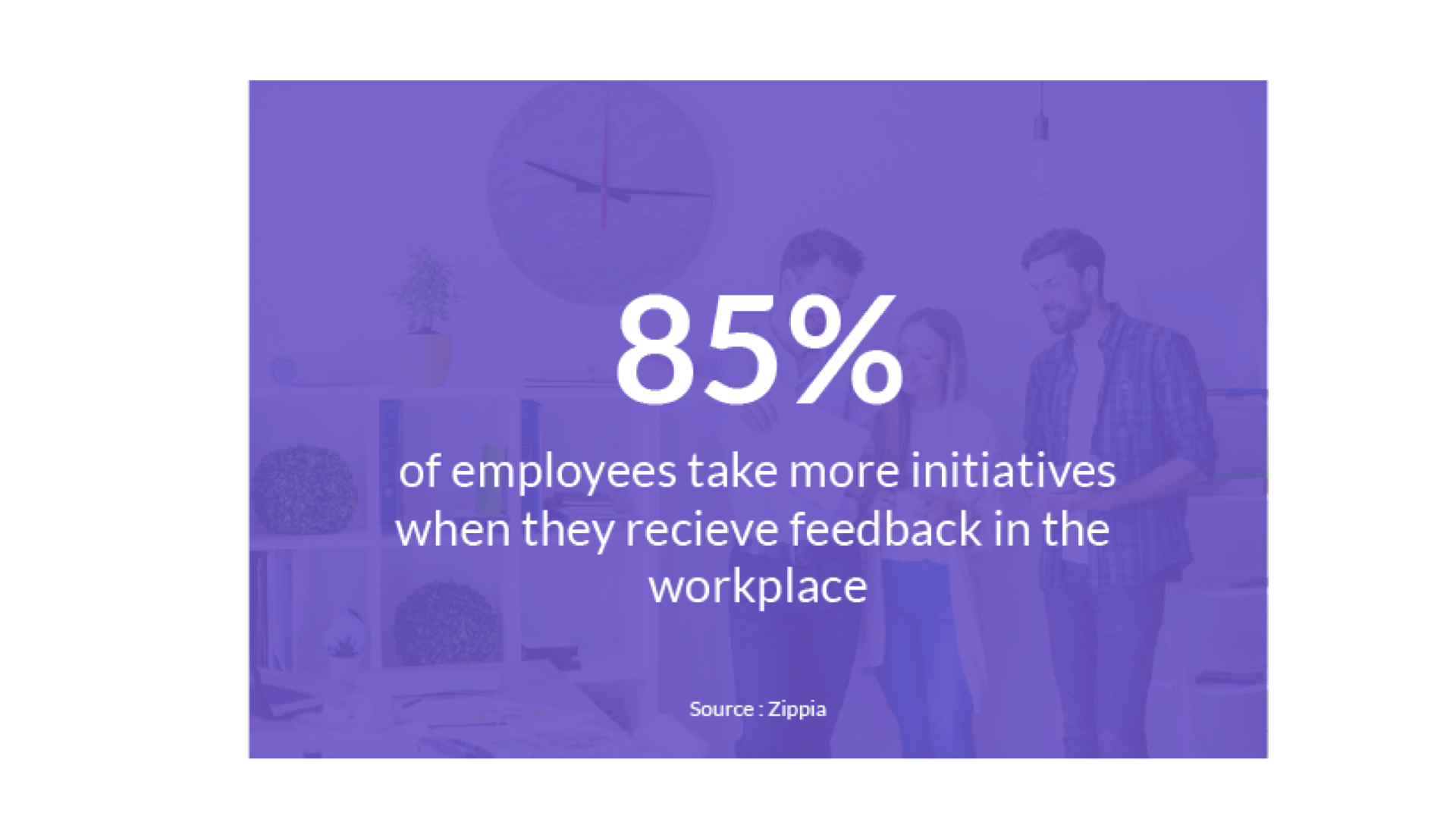
4. Lead by Example
Leadership should embody the principles of the engagement strategy. Managers and executives must demonstrate commitment to employee engagement by participating in initiatives, showing genuine interest in employee welfare, and fostering a positive workplace culture.
5. Having Robust Internal Communication
Robust internal communication is a key engagement strategy as it fosters transparency, trust, and inclusion. When employees are well-informed and heard, they feel connected to the company's mission, boosting their commitment and productivity.
Effective communication channels, like regular updates and feedback systems, ensure employees are engaged, valued, and motivated to contribute to the organization's success.

Models of Employee Engagement**
When it comes to creating a thriving workforce, understanding the models of employee engagement is like having the ultimate blueprint for success. But what exactly do these models tell us about keeping employees motivated, satisfied, and committed? In this section, we’ll break down the most influential frameworks and explore how you can apply these insights to build a more engaged and effective team.
Zinger’s Pyramid of Employee Engagement
- Focuses on foundational needs like well-being and safety.
- Builds on relationships, recognition, and personal growth.
- Aims for high levels of engagement and active participation.
Gallup Q12 Model
- Uses 12 core questions to measure engagement levels.
- Provides insights into areas needing improvement.
- Focuses on clear expectations, recognition, development, and purpose.
Schmidt Model
- Emphasizes recruiting and retaining individuals who fit the company culture.
- Focuses on career opportunities, community connection, fairness, and values alignment.
Deloitte Model
- Highlights meaningful work, supportive management, positive environment.
- Offer growth opportunities, and trustworthy leadership.
- Aims to create a purpose-driven and engaging work culture.
Takeaway
Building a culture of engagement requires continuous effort and commitment. By implementing these strategies and models, organizations can create an environment where employees feel valued, motivated, and connected to their work. This, in turn, leads to improved performance, innovation, and overall success.
Based on findings from a 2021 study, a staggering 73 percent of employees are open to the idea of leaving their current jobs if they receive the right offer, regardless of whether they are actively seeking new opportunities.
Furthermore, According to SHRM, 76% of employees in the US say they are more likely to stay with a company that offers continuous learning opportunities.
Based on findings from a 2021 study, a staggering 73 percent of employees are open to the idea of leaving their current jobs if they receive the right offer, regardless of whether they are actively seeking new opportunities.
Furthermore, According to SHRM, 76% of employees in the US say they are more likely to stay with a company that offers continuous learning opportunities.
Switching jobs isn't solely driven by financial considerations. Surprisingly, 86 percent of millennials would be willing to take a pay cut for the opportunity to work in their dream job. Additionally, 23 percent of job seekers are open to changing positions without requiring a salary increase.
Steps to Create an Employee Engagement Strategy
-
Define Clear Objectives: Establish precise goals and outcomes to guide your engagement strategy effectively.
-
Assess Current Engagement Levels: Evaluate the existing levels of employee engagement to identify areas for improvement.
-
Identify Key Drivers of Engagement: Pinpoint the factors that significantly impact employee engagement within your organization.
-
Involve Stakeholders: Engage employees, managers, and leaders in the process to ensure diverse perspectives and buy-in.
-
Take Actionable Initiatives: Implement tangible and targeted initiatives based on insights gained to enhance engagement effectively.
Things to Remember in an Engagement Strategy
Before we begin, let us have a sneak peek into some must have's

1. Communicate the Strategy
Start by sharing the engagement strategy and its objectives with all employees. Be open about why this strategy is important and how it aligns with our organization's goals.
Deliver clear and consistent messages that underscore the importance of employee engagement and its positive impact on both the individual and the organization.
2. Allocate Resources
Make sure the necessary budget is in place to support the various initiatives in your strategy. This includes funding for training programs, wellness initiatives, recognition programs, and communication efforts.
Additionally, identify and deploy the right HR tools and technologies to manage and track engagement initiatives effectively. Use HR software for employee surveys, data analysis, performance tracking, and reporting.
Many tools in the market offer solutions for these tasks. Using e-NPS-based surveys to actively listen to employee feedback and gauge engagement levels can lead to better insights and more effective engagement strategies.
3. Monitor and Adjust
Regularly monitor the effectiveness of your engagement initiatives through surveys, feedback, and performance metrics. Analyze the data to identify areas for improvement and make necessary adjustments to your strategy. Continuous evaluation ensures that your engagement efforts remain relevant and effective.

4. Lead by Example
Leadership should embody the principles of the engagement strategy. Managers and executives must demonstrate commitment to employee engagement by participating in initiatives, showing genuine interest in employee welfare, and fostering a positive workplace culture.
5. Having Robust Internal Communication
Robust internal communication is a key engagement strategy as it fosters transparency, trust, and inclusion. When employees are well-informed and heard, they feel connected to the company's mission, boosting their commitment and productivity.
Effective communication channels, like regular updates and feedback systems, ensure employees are engaged, valued, and motivated to contribute to the organization's success.

Models of Employee Engagement**
When it comes to creating a thriving workforce, understanding the models of employee engagement is like having the ultimate blueprint for success. But what exactly do these models tell us about keeping employees motivated, satisfied, and committed? In this section, we’ll break down the most influential frameworks and explore how you can apply these insights to build a more engaged and effective team.
Zinger’s Pyramid of Employee Engagement
- Focuses on foundational needs like well-being and safety.
- Builds on relationships, recognition, and personal growth.
- Aims for high levels of engagement and active participation.
Gallup Q12 Model
- Uses 12 core questions to measure engagement levels.
- Provides insights into areas needing improvement.
- Focuses on clear expectations, recognition, development, and purpose.
Schmidt Model
- Emphasizes recruiting and retaining individuals who fit the company culture.
- Focuses on career opportunities, community connection, fairness, and values alignment.
Deloitte Model
- Highlights meaningful work, supportive management, positive environment.
- Offer growth opportunities, and trustworthy leadership.
- Aims to create a purpose-driven and engaging work culture.
Takeaway
Building a culture of engagement requires continuous effort and commitment. By implementing these strategies and models, organizations can create an environment where employees feel valued, motivated, and connected to their work. This, in turn, leads to improved performance, innovation, and overall success.
















